Speculative traders thrive on volatility. Whether looking at crops, minerals, or even oil, many people are sometimes surprised at how volatile commodities can be. That’s why it’s vital to know which markets have the most volatility. In this article, we’ll take a closer look at the commodity markets to find out which ones offer the most opportunity.
Like any other investment market, the price usually boils down to a simple supply and demand issue. However, it is essential to recognize the lead times and production costs when looking at the most volatile commodities. If, for example, there was a sudden shortage of coffee or grain, it is not possible to increase production overnight. The underlying reason is the time necessary to grow individual crops, and it is the same for mineral exploration and the drilling of oil wells. Consequently, when the buffer between supply and demand is reduced, this can lead to extreme volatility, often encouraged by speculative investors.
How Knowing The Most Volatile Commodities Helps Us
At first glance, it may be challenging to recognize how volatile commodities can help those looking to put together investment strategies. It’s not crazy to assume that commodity volatility increases the risk, even if there is profit potential. The reason for market volatility is often a result of limited supplies. Therefore, looking into the background of various tradeable commodities might give us an idea of how much volatility we can expect in that market.
A report by Oliver Wyman casts a fascinating light on volatile commodities and how they impact numerous investment markets. The report found that:
- Commodity price swings are the second-largest driver of earnings uncertainty at publicly traded companies.
- 23% of senior financial professionals consider commodities to be the primary driver of their earnings variability.
Consequently, many private and publicly quoted companies now use the commodity futures markets to secure supplies and fix prices. While supply and demand are central to commodity prices, the macroeconomic outlook plays a dominant role in the big picture.
What’s the benefit of trading volatile commodities?
Volatile commodity markets have been described by some as a “trader’s paradise” for several reasons:
- Price volatility attracts speculative, short-term, and long-term investors/traders
- The mix of investors/traders improves liquidity
- Increased liquidity allows investors/traders to deal in significant contract sizes
- Commodity markets tend to be more transparent and influenced to a lesser extent by government activities
- Constant dealing by arbitrageurs will quickly subdue pricing anomalies
Relatively volatile commodities tend to attract significant numbers of investors due to the potential short-term trading opportunities. The ability to trade in commodity futures also allows for various investment strategies to be created. Whether you are looking at butterfly spreads, calendar spreads, and ways to maximize profit and minimize losses, there are countless options.
While it may seem strange to say this, for many investors, the commodity itself is irrelevant. Later in this article, we’ll demonstrate that the more elements that influence a commodity price, the higher the chance of volatility and trading opportunities.
The Importance of Volatility in Futures Trading
Even though many investors will discuss volatility in futures trading, how exactly is volatility measured? What are the results of those measurements? How do they influence futures markets?
The definition of volatility is as follows:
“A measure of dispersion around the mean or average return of a security.”
The traditional measurement of volatility is standard deviation around the:
- Mean of an asset price
- Average of an asset price
If a commodity price is relatively close to the mean/average, then the standard deviation is relatively small. The highs and lows of the price deviate significantly from the mean/average, indicating relatively high volatility. In theory, the higher the standard deviation, the higher the potential investment return. That is the perfect scenario for many futures traders.
The leveraging effect of option/futures contracts on a relatively volatile commodity can create a precarious situation. The greater the degree of commodity price standard deviation, the greater the effect of leverage on options/futures prices. It’s crucial to be careful!
It is also vital to realize the low-to-negative correlation between traditional stocks/bonds and commodity prices. While the macroeconomic outlook will impact all investment markets to a certain extent, commodities have different influences than stocks/bonds. Consequently, you effectively trade in two very different investment types due to the lack of direct correlation.
How Volatile Are Commodities Compared to Other Assets?
All of this talk of commodity volatility might be difficult to understand without something to compare. A recent report by The Balance gives us a clearer picture of the relative volatility of commodities compared to other asset classes.
| Commodity | Period | Quarterly volatility range |
| Equities (E-mini S&P 500) | 20 years | 5.35% – 27.23% |
| US Bond market | 20 years | 6.22% – 17.5% |
| Dollar Index | From 1988 | 4.37% – 15% |
| Gold | Since 1970 | 4% – 40% |
| Coffee | Since 1970 | 11% – 90% |
| Soybeans | Since 1970 | 10% – 75% |
| Sugar | Since 1970 | 10.5% – 100% |
| Silver | Since 1970 | 10% – 100% |
As you will see from the table above, there are some fascinating variances in volatility across a range of different assets. We have the US bond market and dollar index showing the slightest degree of volatility. In contrast, sugar and silver have volatility measurements of up to 100%.
In more recent times, we have seen the emergence of cryptocurrencies that have generated enormous volatility and, in many cases, massive growth. Since the turn of the century, the price of Bitcoin has increased from less than a cent to around $40,000. While this rise is impressive, during March 2021, it peaked at just over $60,000.
One reason for its popularity is the lack of regulations. Consequently, the growing popularity of cryptocurrencies seems to have ignited the flame of desire amongst many investors.
The Most Volatile Commodities
Let’s look at some of the most volatile commodities available on the futures/options market today. As you will see, we have added one borderline commodity in the shape of Bitcoin to reflect huge investor demand in this area.
You will notice that the most volatile commodities are the foundations for the more liquid futures markets. Liquidity is a vital piece of information for some of the more successful investment funds, the ability to buy and sell in significant contract sizes. In years gone by, we have seen numerous investment funds locked into markets with limited liquidity. It’s is a challenge, especially when investors decide to cash in their units.
Bitcoin
There is no doubt that Bitcoin is the cryptocurrency that put the sector on the map, leading to the release of thousands of different cryptocurrencies. You can trade Bitcoin futures as a means of covering existing positions, diversifying your portfolio, or simply taking a speculative gamble. When you bear in mind the price of a Bitcoin has increased from less than a cent to more than $60,000 (falling back to $40,000) since the turn of the century, volatility figures for it are pretty much irrelevant. They are sky-high!
While regulations continue to hover over the cryptocurrency sector, the sector might be too big to fail. Central banks and governments worldwide will need to accommodate this emerging asset class, which many believe will become a standard part of future asset allocation. While there are some reasonably high expectations for the cryptocurrency sector as a whole, and in particular Bitcoin, there are still many factors to consider.
The volatility of Bitcoin has attracted the attention of short-term traders and long-term investors. You can now buy Bitcoin futures as a means of leveraging has caught the attention of many. One for the brave!
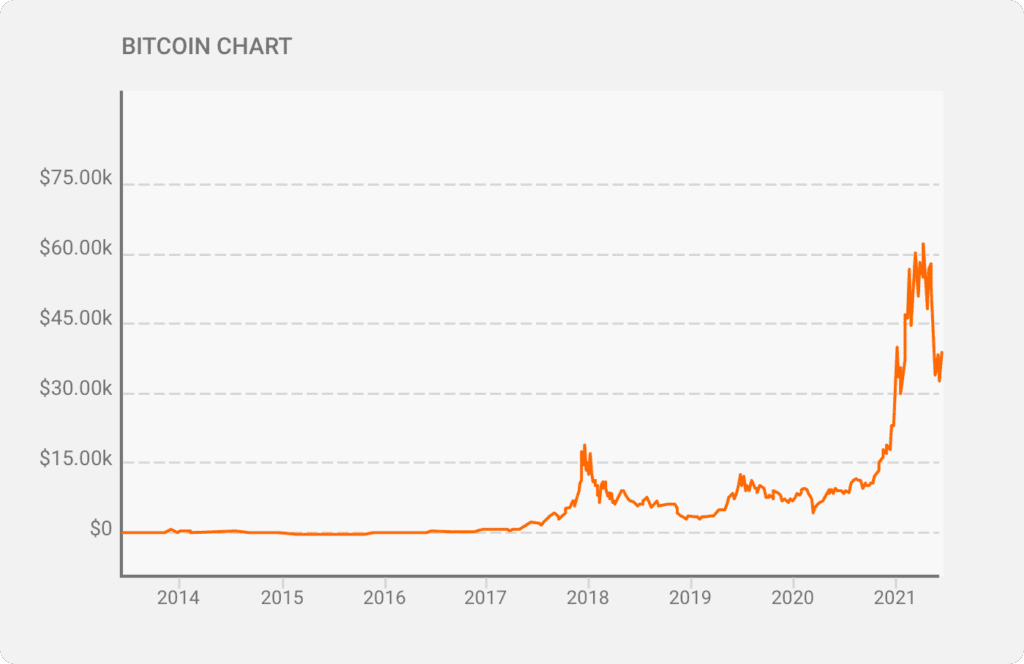
On a side note, in addition to the mainstream cryptocurrencies (digital currencies), you will come across the term Altcoins in years to come. The word is a portmanteau simply stands for alternative coins, i.e., alternative cryptocurrencies, which tend to be much smaller and focused on niche markets. Be careful! Like cryptocurrencies, there is little in the way of regulation with experts comparing some markets to the “Wild West.”
Cotton
At first glance, there seem to be several common themes and common patterns. As you can see from the chart below, the 45-year chart of the cotton price may not have moved much in dollar terms, but it has shown substantial percentage swings. However, on further investigation, this is not always the case. We know seven significant factors impact the price of cotton and, therefore, the cotton futures market:
- Global stockpiles
- Government policies
- Global demand
- Climate
- Substitutes
- Oil prices
- The US dollar
The issue of global warming has been in the headlines for some time. It’s just one more factor that cotton plantations and those growing similar products will need to adapt. So, not only do we have profoundly entrenched volatility trends but new emerging factors.
Cotton 45 Year Chart (per pound)
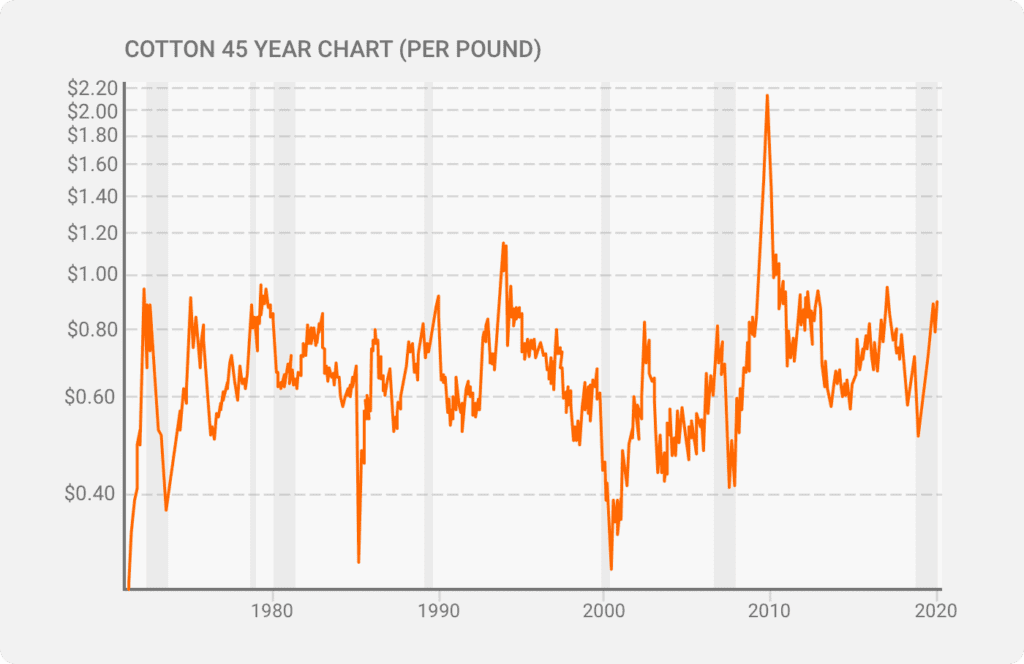
Soybeans
The soybean market has gone from relative obscurity in the 1970s to a peak of nearly $18 per bushel in 2012. The price currently stands around $16 a bushel after a relatively sharp upward movement in 2020. There are numerous issues to take into consideration regarding the direction of the soybean price, such as:
- The impact of varied climate conditions
- Increased soybean protein demand
- China imports around 60% of global soybean imports
- Priced in US dollars, it will vary according to the US dollar rate
- Trade tariffs
- Price relative to other crops such as corn
- Stock levels
- Energy costs
- Speculative investors
In many ways, the rising soybean price reflects a new Asian diet trend, a move towards pork, poultry, and beef instead of rice. A vital source of animal feed, soybeans dominate the protein feed market.
When you consider the historic volatility of the soybean price, a significant shift in dietary trends in China and broader Asia, it is no surprise that speculative investors have shown an interest.
Soybean 45 Year Chart (per bushel)
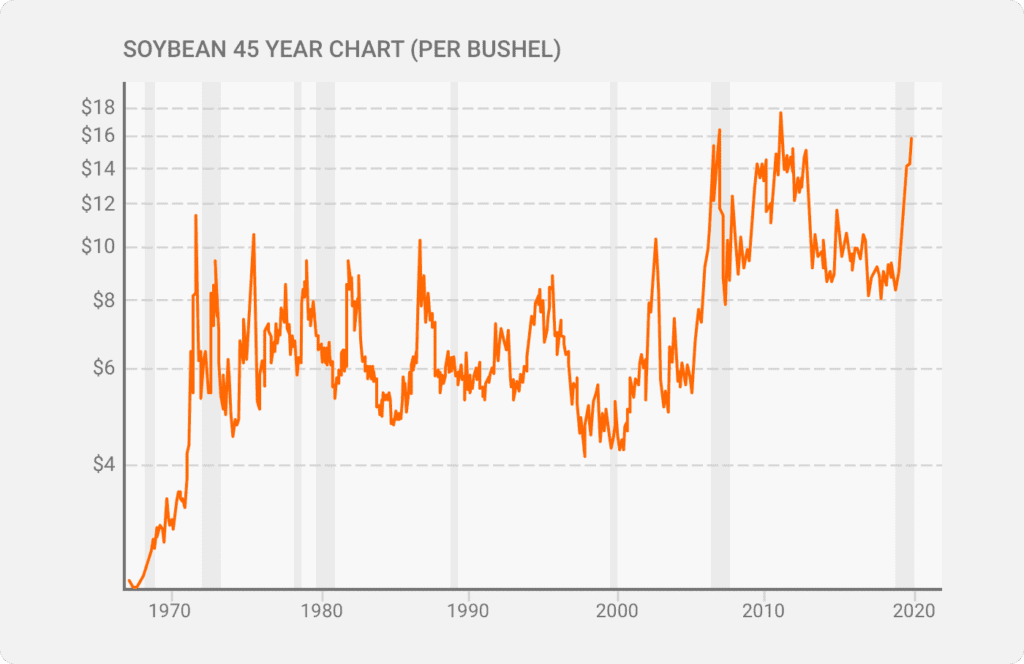
Crude oil
Oil has been and will continue to be one of the more volatile commodities, attracting more than its fair share of futures trading. Let’s look at the chart below. As you can see, there has been extreme volatility over the years. It peaked at $170 a barrel in 2008 against a recent low of around $20 a barrel in 2020.
When evaluating oil as an investment, many people automatically think of fuel without considering the role of oil in the production of plastics and other materials. Here are a few different factors that impact the price of crude oil:
- OPEC policies on oil supply
- Simple supply and demand
- Futures contract activity
- Changing energy policies, such as the move towards electric vehicles
- Production costs
- Disruption of supply
- Seasonal demand
- Global warming
- Politics/conflict
Over the years, we have seen concerns regarding a glut of oil, shortage of oil, and everything else in between. There are many different factors to consider, making oil futures so attractive to speculators and industry participants.
Crude Oil 70 Year Chart (per barrel)

Gold
The gold futures market is one of the more popular for a variety of reasons. Over the last ten years, the price of gold has peaked at more than $2,000 per ounce. Conversely, it also fell below $1,000 an ounce in 2015. There is a common misconception that the price of gold revolves around jewelry. However, that’s not always the case! Take a look at the chart below.
Because gold is not consumed, the amount of gold in the world grows each year, as we min more and more. On that basis, you might expect the price of gold to fall as the supply increases. However, the demand for gold for jewelry continues to rise, too, so the market is more than able to keep up with the increasing supplies.
In countries such as India and China, gold is purchased as a store of value and unlikely to make it back onto the market. The same can be said of various types of gold jewelry, which are often stored in the drawer, part of a family heirloom, and retained in the longer term. Therefore the amount of gold in circulation is nowhere near what you might have assumed.
In summary, some of the factors which move the gold price include:
- Used as a hedge against inflation during difficult economic times
- Central banks continue to reduce their gold reserves
- Demand for gold jewelry
- Investment, especially for portfolio diversification
Gold has been an element of many investment portfolios for years. It is the ability to “retain value” which can provide stability during difficult times. Consequently, it will be no surprise to learn that gold futures markets are particularly liquid, and investors can deal in significant contract sizes.
Gold 10 Year Chart (per ounce)
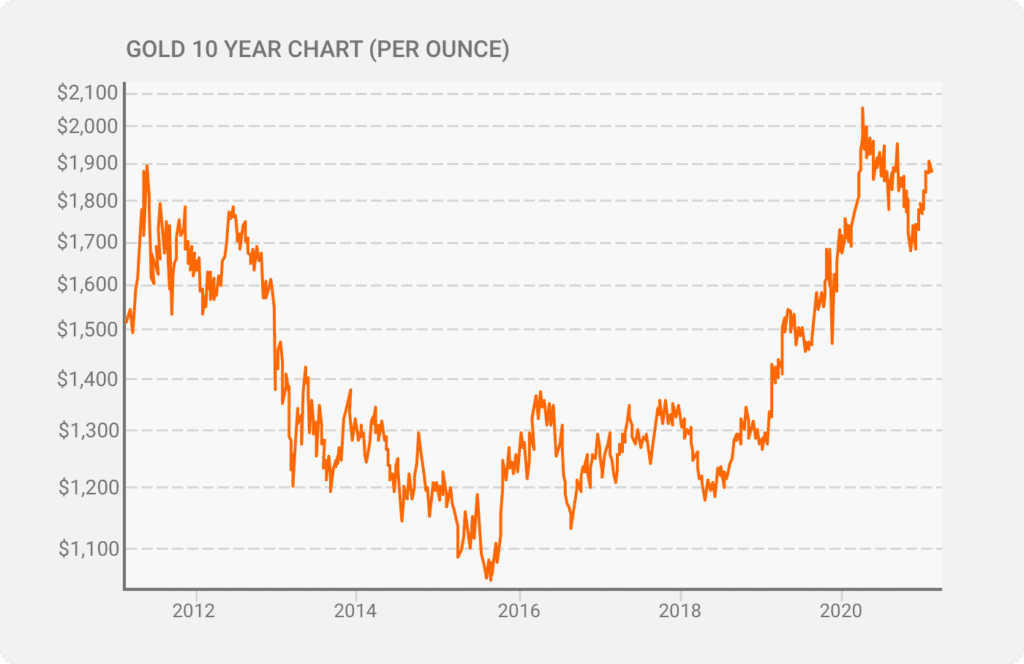
Coffee
Coffee is a breakfast staple for millions of people around the world. It is one of the more heavily traded commodity futures markets. That’s why it continues to attract investor interest. While the price variation may be limited in terms of dollars, you can see some relatively large swings in the percentage movement chart below. These circumstances present the perfect scenario for speculative/short-term traders and an essential means for commercial buyers and sellers to fix future trade prices.
Numerous factors can have an impact on the price of coffee, which includes:
- Developing markets: more disposable income tends to lead to an increase in coffee consumption
- Weather/climate can have a significant impact on crops
- Industrialization/urban growth
- Crop disease
- Increased overall demand
- Speculative interest
In recent times we have seen an upswing in the price of coffee, perhaps a reflection of both growing demand in new developing markets and the impact of global warming. Whether this continues remains to be seen. However, the volatile nature of the price of coffee has created an intense and liquid marketplace.
Coffee 45 Year Chart (per pound)
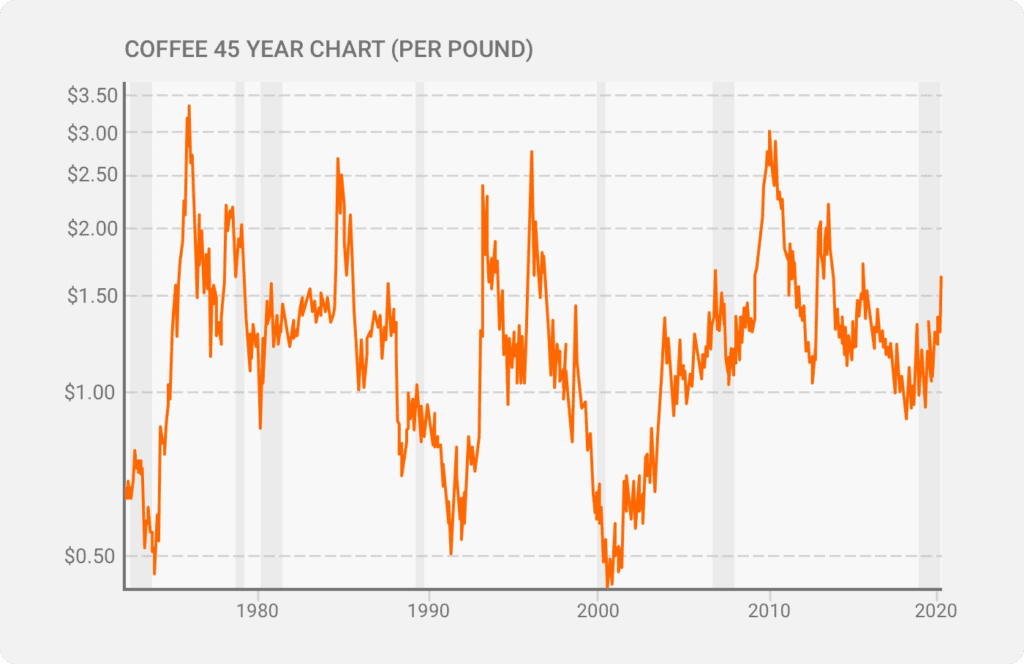
Sugar
The chart below shows the price of sugar in US dollars per pound going back over the last 45 years. As you will see in the list below, one of the main factors impacting sugar prices is oil prices. Yes, oil prices.
Sugarcane can be used to produce sugar or ethanol, a type of fuel. As a consequence, the price of ethanol has an enormous impact on sugar prices. If the ethanol price is low, demand for raw sugarcane will fall, creating a potential oversupply in the marketplace. As we touched on above, if there is a shortage or surplus of a particular commodity, it is not simply a case of flicking a switch to increase/reduce production.
In summary, the main factors influencing the price of sugar include:
- Global sugar inventory
- US dollar currency movements
- Price of oil (impacting ethanol demand)
- Weather conditions for crops
- Changing government regulations
- Consumer trends
Experienced investors, especially those looking at the futures market, will focus on the standard deviation of a commodity price instead of the actual price. So, swings between one cent per pound and $0.60 a pound are more than enough to support a liquid and fast-moving sugar futures market.
Sugar 45 Year Chart (per pound)
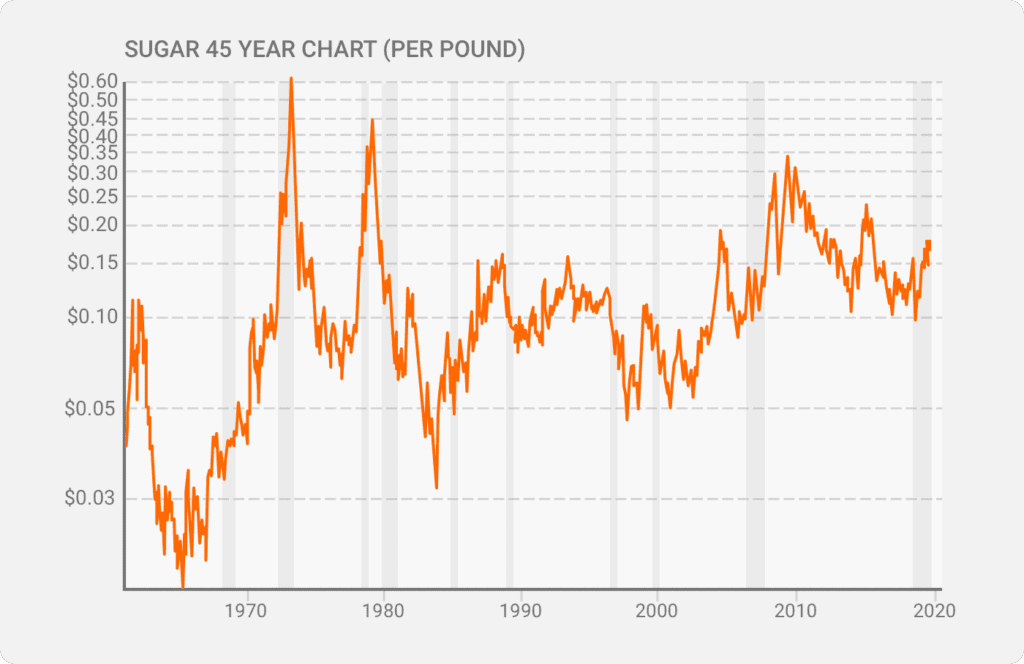
Final Thoughts
There are many factors to take into consideration when looking at futures/options trading. Aside from the apparent investment issues to consider, it is vital that the market is liquid, has depth, and is likely to remain in demand going forward. That’s why traditional commodity markets such as gold, sugar, coffee, soybean, etc., have supported highly liquid futures trading for many years.
If you put yourself in the place of the multibillion-dollar investment funds, you need to be able to buy and sell in significant quantities. Even though some smaller commodities markets seem attractive, an investment may be counterproductive if a substantial purchase or sale could disproportionately move the underlying commodity price.
Liquid commodity markets attract high-value investors, investment funds, and speculators. This broad range of participants gives the market liquidity and additional depth, which then attracts more investors. At this point, we haven’t even begun looking at the commercial entities involved in purchasing and selling said commodities.
There are many different factors to consider across the most volatile commodities traded today. While the underlying influence is simply supply/demand, it isn’t always cut and dry.

